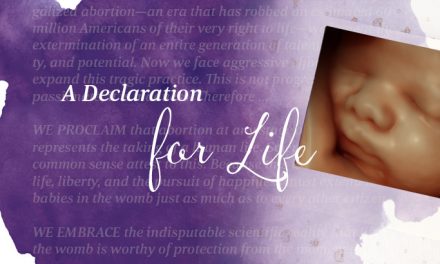By now you may have read that 182 conservative lawmakers voted against the House bill to revive the Equal Rights Amendment. Critics have charged many of those legislators with sexism – but nothing could be farther from the truth.
As it is, the innocuously worded amendment affirming that “equality of rights under the law shall not be abridged … on account of sex” cloaks a radical pro-abortion agenda.
“Of course I believe in equal rights,” Rep. Jackie Walorski (R-Ind.) said. “[But] let’s be honest, this is not about equality or women’s rights. This is about enshrining unrestricted abortion in the Constitution and allowing full taxpayer funding for abortion.“
ERA advocates, such as House Speaker Nancy Pelosi, claim the bill has “nothing to do with the abortion issue.”
However, if the ERA were ratified, a judge could strike down any abortion regulation or funding limitation. Because only women request abortions, any law restricting abortion or abortion funding would be considered sex inequality.
Pro-life legislators’ concerns regarding the ERA are, in fact, warranted.
ERA advocates who are more transparent than Pelosi have stated that the ERA is fundamentally about abortion rights.
“There are no equal rights for women without access to abortion, plain and simple,” said Alexis McGill Johnson, acting president and CEO of Planned Parenthood.
A pro-abortion Supreme Court Justice argued fifty years ago that equal rights legislation is the best strategy to promote abortion rights. Justice Ruth Bader Ginsburg believed that an equal rights provision would have avoided the backlash incited by Roe v. Wade.
The court decided in Roe v. Wade that a woman’s “fundamental” right to abort a pregnancy was derived from the concept of personal autonomy. Roe would have been less controversial, Ginsburg argues, if the court had declared abortion a matter of sex discrimination. In the 1970s, the Supreme Court overturned laws with sex-based classification without any significant backlash.
Roe v. Wade was also too clear, according to Ginsburg. It included too many details that the pro-life lobby could disagree with. As one professor noted, Roe “[reads] like a set of hospital rules and regulations.”
The ERA has both qualities Ginsburg preferred for advancing abortion: it would make abortion a sex discrimination issue and it is vague enough that pro-life groups could not oppose any distinct provisions.
Pro-life groups have offered to take a neutral stance on the ERA if it included language stating it would not apply to abortion laws. ERA supporters have refused to compromise because they believe abortion is essential for women’s “equality.”
At the state level, Equal Rights Amendments have already been used to lobby for pro-abortion policies. Groups such as Planned Parenthood and the American Civil Liberties Union have submitted countless court filings arguing for publicly funded abortion based on state-level ERAs.
In 1998, the New Mexico Supreme Court ruled that the state constitutional ERA mandates public funding for abortion.
It is slanderous to suggest that conservative legislators who oppose the ERA are misogynists. Legislators who voted against the ERA understand that it is a Trojan horse for unrestricted and taxpayer-funded abortion.






